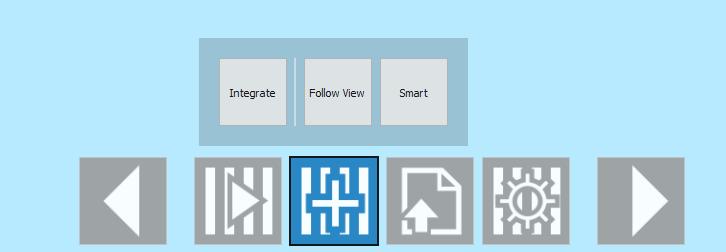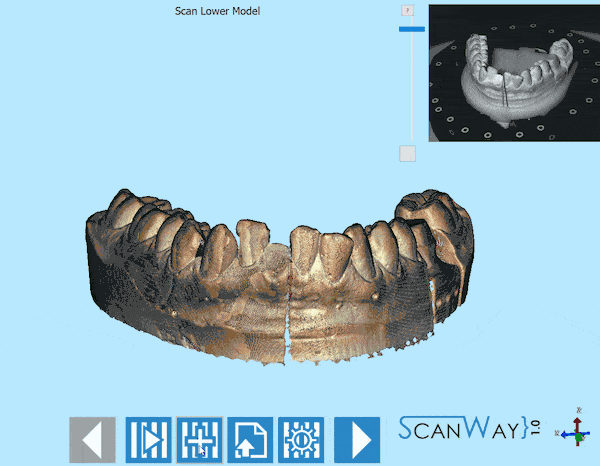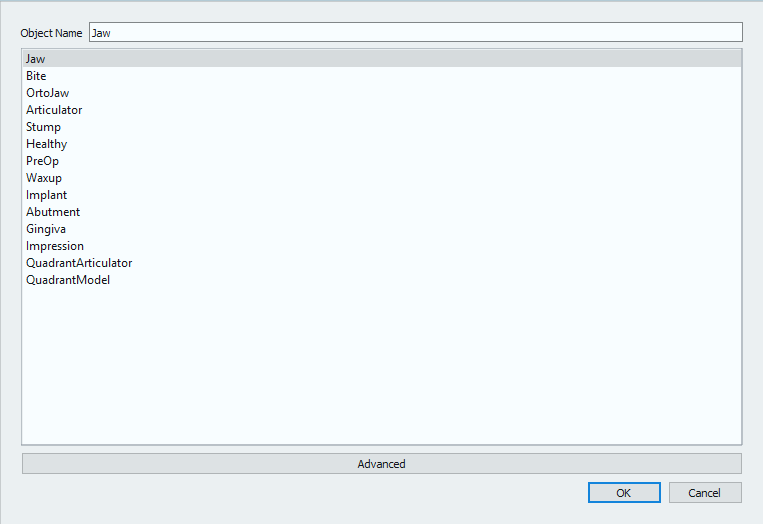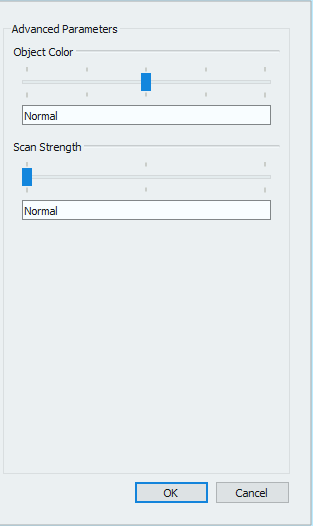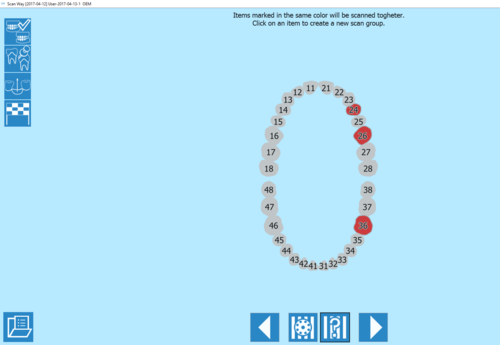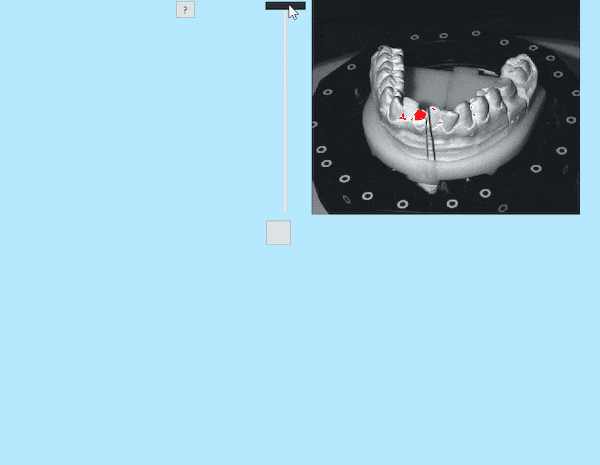Scan Interface
Contents
Estrutura
A interface de digitalização é a parte do assistente que regula a aquisição de imagens em 3D. A barra de ferramentas principal oferece ferramentas específicas para o escaneamento e a visão ao vivo das câmeras no canto superior direito permite verificar a posição do objeto na câmara de escaneamento e a quantidade de luz que a atinge
Barra de ferramentas de escaneamento
As ações na barra de ferramentas de escaneamento podem variar dependendo da etapa em andamento. Aqui abaixo uma lista de todos os ícones possíveis, suas aplicações e etapa de referência:
- Template:Botão de lista Anterior
- volta para a etapa anterior. Ícone não ativo durante a primeira etapa de escaneamento.
- Template:Botão de lista Escanear
- Inicia o procedimento de aquisição específico para a etapa em andamento. Este ícone está sempre disponível.
- Template:Botão de lista Integrar
- Permite adicionar imagens aos já adquiridos na etapa em andamento. Este ícone não está disponível na etapa de escaneamento do articulador e antes da verificação ser efetivamente realizada. Esta ação será melhor explicada mais adiante nesta página.
- Template:Botão de lista Importação
- permite importar um arquivo para a imagem desejada em vez do escaneamento. Este ícone está sempre disponível.
- Template:Botão de lista Parâmetros avançados
- Permite configurar um procedimento de escaneamento diferente para a etapa em andamento. Esta ação será melhor explicada mais adiante nesta página.
- Template:Botão de lista Copiar da referência
- Permite copiar uma imagem adquirida anteriormente para a etapa em andamento. Esta ação está disponível nos saudáveis e pontes, e nas etapas de escaneamento do Waxup. Esta ação é totalmente automática, o que significa que a imagem copiada já está mostrada na etapa sem ter que clicar no ícone relevante. O usuário ainda pode decidir verificar o objeto novamente e depois copiar a primeira referência se a última verificação não for satisfatória.
- Template:Botão de lista Avançar
- Avança um passo para frente no projeto. Este ícone está disponível quando a etapa em andamento está concluída ou em etapas que podem ser ignoradas.
Quando o escaneamento é iniciado, uma roda de progresso será mostrada. O escaneamento pode ser interrompido clicando no botão Template:Botão Inline.
Integração
A ação de integração permite adicionar informações ao escaneamento sem ter que re-escanear novamente o objeto com o procedimento completo. Ao clicar no botão Template:Botão inline, o 'painel de integração' abre.
Há duas maneiras de realizar uma integração. Para escolher um dos dois métodos, clique no botão relevante, para iniciar a integração, clique no botão Integrar
- Siga a Visualização
- clique em 'Seguir a visualização' . Mova o objeto 3D no espaço e centre a exibição nas informações que faltam. Verifique se o ponto que você precisa escanear novamente é visível na visualização ao vivo das câmeras e clique em 'Integrar' .
- Smart
- Click on Smart. A little progress bar will appear and, when it gets to 100%, all the holes or missing information will be marked in yellow on the acquired image. Left click near the yellow lines to select an area that needs to be rescanned. The selected areas will be marked in red. Click on integrate to launch the scan sequence that will try to cover up all the selected areas of missing information.
Advanced Parameters
The Advanced Parameters button ![]() opens the profile and parameters selection dialog.
opens the profile and parameters selection dialog.
Every object is scanned with a different procedure, to get all the details of the different shapes that can be scanned and avoid to use an unnecessarily elevated number of images for a reference object. For instance, the articulation scan will be performed with only four images on an horizontal plan and reduced speed to avoid loosing the balance of the occlusion; on the other hand, the models will be scanned with 6 images on a low tilt, the dies with 12 images on a higher tilt and so on.
These profiles are Open Technologies' suggestion on how to scan a determined object, but it is not said that they should be always the best procedures, seen that dental objects are seldom similar. Starting from this assumption, the user is always free to decide whether to change the scan profile or not by selecting any other voice in the profile list to increase or reduce the number of images and detail. Of course, the higher the level of detail, the higher the number of images, the heavier the resulting file.
Moreover, by clicking Advanced on the bottom of the dialog, the user will be able to change some advanced parameters of the selected scanning profile.
There are two parameters that can be modified:
- Object Color
- The shade of the specific kind of object. Like in the live view of the cameras, this parameter controls the amount of light that will hit the object; if the object is very dark it will need to be scanned with a brighter beam and vice versa.
- Scan Strength
- This parameter allows to higher the contrast of the scanning pattern to better scan difficult surfaces (translucid, metallic etc). The more the selected strength, the more time the scan will take.
Die Scan Definition
Die scanning works the same as all the other scanning steps, but it has an intermediate definition step with which the user can decide to either use the Multi die plate (default choice) or to mark a custom die scan setup.
The multi die definiton ![]() appears automatically at the beginning of the dies scanning step. The 9 positions of the multi die will be filled starting from the elements of the first quadrant, if there are any, and follows the standard numbering order. The wizard will show in which position to insert each die. If the dies exceed the number of positions, a further step will be added to the wizard to scan all the elements defined in the project.
appears automatically at the beginning of the dies scanning step. The 9 positions of the multi die will be filled starting from the elements of the first quadrant, if there are any, and follows the standard numbering order. The wizard will show in which position to insert each die. If the dies exceed the number of positions, a further step will be added to the wizard to scan all the elements defined in the project.
If the multi die plate is used, the software will already know which die is in which position, and there will be no need to further identify the items that will be automatically aligned to their reference.
As an alternative to the use of the multi die plate, the user can set a custom die scan order by clicking on the custom setup ![]() button.
button.
The software will mark all the items to be scanned in the same color which means that, by default, they would need to be scanned together. By clicking on one of the items to scan, the tooth will change color and will create a second scan group. Click then on all the items to be scanned in that second scan group. By clicking a second time on one of the already selected items, a further scan group will be created and marked in a third color. This operation can be repeated as many times as one wishes, remember that all the items marked in the same color will be scanned together.
In this mode, the software cannot know which item is scanned in which position, therefore it will require the user to identify each stump. Identification procedure will be explained in the Edit Tools page.
Marker Scan Definition
The marker (or scanbodies) scan is similar to the custom setup of the dies scan.
The software will mark all the items to be scanned in the same color which means that, by default, they would need to be scanned together. By clicking on one of the items to scan, the tooth will change color and will create a second scan group. Click then on all the items to be scanned in that second scan group. By clicking a second time on one of the already selected items, a further scan group will be created and marked in a third color. This operation can be repeated as many times as one wishes, remember that all the items marked in the same color will be scanned together.
The software cannot know which marker is scanned in which position, therefore it will require the user to identify each scanbody. Identification procedure will be explained in the Edit Tools page.
Live view
The live view of the software, on the upper right corner, allows to check the position of the object and the amount of light with which it will be scanned.
For different objects in the same project the light might need to be changed to avoid reflections and improve the scan quality.
The light intensity can be regulated using the bar on the left side of the window.
The red markings show the areas of the objects that are over-exposed and will be more problematic to acquire. Be careful not to lower too much the light intensity, as to do so, the scan quality will be worsened.
